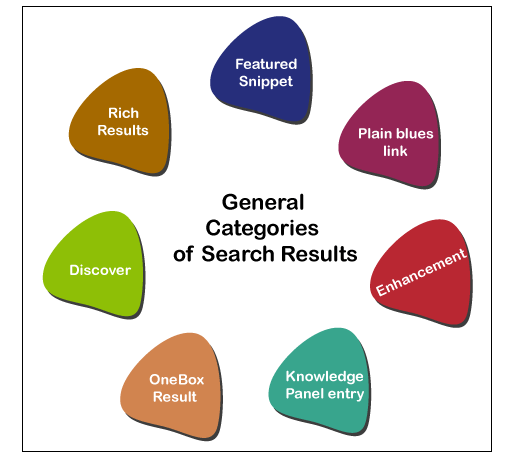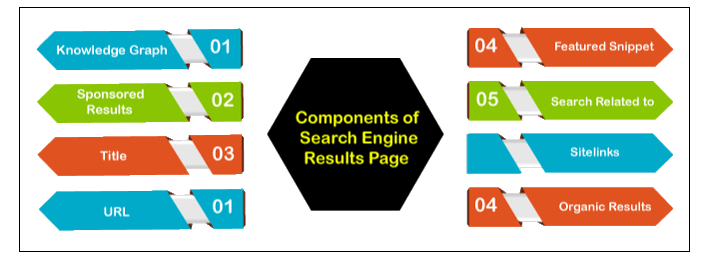Search ResultSearch Result is defined as a list which is generated by the search engines to answer queries of the users. Generally, Search Results are divided into two types:
1. Natural Search Results: - The natural search results appear on the left side of the search engine results page. In this, we can see all the websites that are relevant to the query in the search engine index. The internal evaluation algorithm of the search engine helps to determine what position a website will obtain in the search results. In natural search results, we cannot move the website up by paying. In addition to that, natural search results frequently show entries relevant to a search term from the Google Places, video, or images. Generally, at the top of the search results, these entries appear. 2. Sponsored Search Results: - The sponsored search results appear on the right side of the search engine result page. In the sponsored search results, we can see those websites which places ads with the search engine. There are various factors that determine the sponsored search results, such as search term competition, click-through rates, and price per click. General Categories of Search ResultsThere are various types of display features of Google search results. The look of the search result changes over time, and it is also possible that the same result can be shown differently. Still, it depends on the device which we use in a desktop computer, you can see the different look of the search results, and on a mobile phone, there is a different look. For the search result, Google always tries to present the result in the most useful format. There are various categories of Search Results:
1. Plain Blue Link: - The "Plain Blue Link" term is not an official term, but frequently we used this term outside our official documentation. There are various components included in this type of Search Results:
2. Enhancement: - We can enhance our rich or plain result using various kinds of enhancements, including Search boxes, breadcrumbs, corporate logos, site links, etc. 3. Knowledge Panel Entry: - Google knowledge panel can be defined as a group of information from the various pages, which is shown in the rich result along with text, links, and images. Visually it is tough to distinguish between knowledge panel result and rich card result. 4. OneBox Result: - There is an inline answer which is present in the One Box result. For example, local time OneBox or translation OneBox. We cannot add a custom OneBox to the search results. 5. Discover: - It is not the part of the Google search results, but in the form of a scroll list, our page may appear. Each result card is a one-page summary. 6. Rich Result: - A rich result is defined as a result that comprises of graphical elements with thumbnail images, review stars, or some visual enhancement. 7. Featured Snippet: - If in the Google search, users ask the question, then we may be showing a search result which is extracted from our site at the top of the search result page in a particular featured snippet block. 
Components of a Search Engine Results PageThere are following components of the search engine results page:
1. Title: - The first part of the search result is the title that people read first. The title should be short, relevant, and provide user with great idea about our page. The length of the title is only up to 70 characters. If the length of the title is longer, then Google will truncate it. 2. URL: - The rules which we apply with the title are also applied with the URL. The URLs must be short and relevant. It also provides the information about the page. Underneath the URL, we will often find the timestamps. For news articles and blogs, it is quite common to highlight the freshness of the content. It is must to refresh our content frequently to avoid treating our work as inappropriate or outdated. 3. Featured Snippet: - Another component of the search result is snippet. It is the description of the page. There are only up to 156 characters that we can use for the description of the search results. Although the snippet is the meta description which we wrote, sometimes Google associates the snippet with relevant information on the page. With the help of this, Google can snippet each specific search query in order to provide relevant information related to that search. But they are not making up words. They are pilling it out of our content-just not always from a similar location. Thus, writing a practical meta description is not so important and includes information that is easy-to-digest across the page so that Google can source and identify it. Then we have rich snippets. The Rich snippets offer some extra information like star rating or photograph. Because the rich snippets are more pleasing visually and provide a good jumping-off point, they also have more click through rates. If we are adding structured data to our site, then the chances of getting a rich snippet can be increased. 4. Searches Related to: - The sections related to the search display other top search queries that are relevant to the one that we originally searched. If we want to get other keywords in our content, then this is the correct place. All over our content, scatter these keywords and consider including some in your subheads. 5. Sitelinks: - The sitelinks are the extra sub-lists which appear below the Google search result, generally for the recognizable organizations and brands. By using these links, users can easily jump to the right page on the website. Six is the maximum number which can be allotted to the sitelinks. How many sitelinks any search results obtain is dependent on the uniqueness of the content on the website and how well the website is structured. 6. Organic Results: - The organic results are the lists that search engine generate on the basis of the metrics series, which determines their relevance to the search term. The webpages which score well on the algorithmic test of the search engine appear in this list. There are various factors on which these algorithms are dependent, such as backlinks, quality, the trustworthiness of the websites, expertise, good user experience, and author on a given topic. Generally, on the first page, users tend to view the first result. There are 10 organic listings that every search result page contains. 7. Sponsored Results: - All the leading search engine, along with the substantial market share, accepts paid listings. This exclusive form of the search engine guarantees that our site displays in the top results for those keywords which we have pointed. The Paid search listings are also referred to as sponsored listings or PPC (Pay Per Click Listings). 8. Knowledge Graph: - There are various search engines like Google or Bing that have begun expanding their data into Encyclopedia and some other rich information sources. For example, Google calls this type of information "Knowledge Graph" whenever the search query is matched, then it will show an extra sub-window which appears on the right-hand side, taking information from its source. Information is related to the hotels, places, sports groups, movies, product (like puma), flights, etc 
Next TopicBSE
|
 For Videos Join Our Youtube Channel: Join Now
For Videos Join Our Youtube Channel: Join Now
Feedback
- Send your Feedback to [email protected]
Help Others, Please Share









